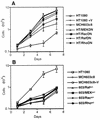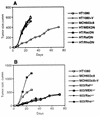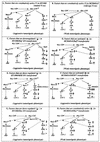Dissection of Ras-dependent signaling pathways controlling aggressive tumor growth of human fibrosarcoma cells: evidence for a potential novel pathway
- PMID: 11094080
- PMCID: PMC102186
- DOI: 10.1128/MCB.20.24.9294-9306.2000
Dissection of Ras-dependent signaling pathways controlling aggressive tumor growth of human fibrosarcoma cells: evidence for a potential novel pathway
Abstract
Activation of multiple signaling pathways is required to trigger the full spectrum of in vitro and in vivo phenotypic traits associated with neoplastic transformation by oncogenic Ras. To determine which of these pathways are important for N-ras tumorigenesis in human cancer cells and also to investigate the possibility of cross talk among the pathways, we have utilized a human fibrosarcoma cell line (HT1080), which contains an endogenous mutated allele of the N-ras gene, and its derivative (MCH603c8), which lacks the mutant N-ras allele. We have stably transfected MCH603c8 and HT1080 cells with activating or dominant-negative mutant cDNAs, respectively, of various components of the Raf, Rac, and RhoA pathways. In previous studies with these cell lines we showed that loss of mutant Ras function results in dramatic changes in the in vitro phenotypic traits and conversion to a weakly tumorigenic phenotype in vivo. We report here that only overexpression of activated MEK contributed significantly to the conversion of MCH603c8 cells to an aggressive tumorigenic phenotype. Furthermore, we have demonstrated that blocking the constitutive activation of the Raf-MEK, Rac, or RhoA pathway alone is not sufficient to block the aggressive tumorigenic phenotype of HT1080, despite affecting a number of in vitro-transformed phenotypic traits. We have also demonstrated the possibility of bidirectional cross talk between the Raf-MEK-ERK pathway and the Rac-JNK or RhoA pathway. Finally, overexpression of activated MEK in MCH603c8 cells appears to result in the activation of an as-yet-unidentified target(s) that is critical for the aggressive tumorigenic phenotype.
Figures









Similar articles
-
Role of phosphoinositide 3-kinase in the aggressive tumor growth of HT1080 human fibrosarcoma cells.Mol Cell Biol. 2001 Sep;21(17):5846-56. doi: 10.1128/MCB.21.17.5846-5856.2001. Mol Cell Biol. 2001. PMID: 11486024 Free PMC article.
-
Differential contribution of the ERK and JNK mitogen-activated protein kinase cascades to Ras transformation of HT1080 fibrosarcoma and DLD-1 colon carcinoma cells.Oncogene. 1999 Mar 11;18(10):1807-17. doi: 10.1038/sj.onc.1202482. Oncogene. 1999. PMID: 10086335
-
Paired human fibrosarcoma cell lines that possess or lack endogenous mutant N-ras alleles as experimental model for Ras signaling pathways.Methods Enzymol. 2001;333:290-306. doi: 10.1016/s0076-6879(01)33064-1. Methods Enzymol. 2001. PMID: 11400345
-
Role of Ras/Raf/MEK/ERK signaling in physiological hematopoiesis and leukemia development.Immunol Res. 2011 Apr;49(1-3):248-68. doi: 10.1007/s12026-010-8187-5. Immunol Res. 2011. PMID: 21170740 Review.
-
The effects of mutant Ras proteins on the cell signalome.Cancer Metastasis Rev. 2020 Dec;39(4):1051-1065. doi: 10.1007/s10555-020-09912-8. Cancer Metastasis Rev. 2020. PMID: 32648136 Free PMC article. Review.
Cited by
-
The role of transgenic mouse models in carcinogen identification.Environ Health Perspect. 2003 Apr;111(4):444-54. doi: 10.1289/ehp.5778. Environ Health Perspect. 2003. PMID: 12676597 Free PMC article. Review.
-
A quantitative comparison of human HT-1080 fibrosarcoma cells and primary human dermal fibroblasts identifies a 3D migration mechanism with properties unique to the transformed phenotype.PLoS One. 2013 Dec 3;8(12):e81689. doi: 10.1371/journal.pone.0081689. eCollection 2013. PLoS One. 2013. PMID: 24349113 Free PMC article.
-
Roles of the Ras-MEK-mitogen-activated protein kinase and phosphatidylinositol 3-kinase-Akt-mTOR pathways in Jaagsiekte sheep retrovirus-induced transformation of rodent fibroblast and epithelial cell lines.J Virol. 2005 Apr;79(7):4440-50. doi: 10.1128/JVI.79.7.4440-4450.2005. J Virol. 2005. PMID: 15767444 Free PMC article.
-
Inhibitors of Ras/Raf-1 interaction identified by two-hybrid screening revert Ras-dependent transformation phenotypes in human cancer cells.Proc Natl Acad Sci U S A. 2002 Oct 29;99(22):14398-403. doi: 10.1073/pnas.222222699. Epub 2002 Oct 21. Proc Natl Acad Sci U S A. 2002. PMID: 12391290 Free PMC article.
-
Role of phosphoinositide 3-kinase in the aggressive tumor growth of HT1080 human fibrosarcoma cells.Mol Cell Biol. 2001 Sep;21(17):5846-56. doi: 10.1128/MCB.21.17.5846-5856.2001. Mol Cell Biol. 2001. PMID: 11486024 Free PMC article.
References
-
- Bishop J M. The molecular genetics of cancer. Science. 1987;235:305–311. - PubMed
-
- Boettner B, Van Aelst L. Rac and Cdc2 effectors. Prog Mol Subcell Biol. 1999;22:135–158. - PubMed
-
- Bokoch G M, Der C J. Emerging concepts in the Ras superfamily of GTP-binding proteins. FASEB J. 1993;7:750–759. - PubMed
Publication types
MeSH terms
Substances
Grants and funding
LinkOut - more resources
Full Text Sources
Research Materials
Miscellaneous
